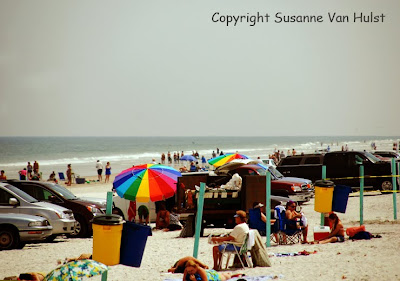The beach in New Smyrna Beach - park your car right on the beach
The beach where people are driving their cars out on the sandy beach
View trough the fence
The perfect match: an old Studebaker car and the typical old beach town Motel,
say "Hello" to Nostalgia.
The colony suffered major losses due to insect-borne diseases and Native American raids; and tensions grew due to mistreatment by Turnbull. Due to these complications, the remaining colonists marched north to St. Augustine along the Old King's Highway, to claim mistreatment by Turnbull to the Governor of Florida in St. Augustine in 1777; then a British protectorate..
Soon after, St. Augustine was returned to the Spanish, and Turnbull abandoned his colony for life in Charleston, South Carolina.
The St. Photios National Shrine on St. John's Street in St. Augustine, Florida, honors the settlers of New Smyrna, who were the first Greek Orthodox followers in North America. The historical exhibit adjoining the Chapel tells the moving story of their plight in great detail, with accompanying exhibits.
The area was then only sparsely populated due to the frequent raids by Seminole Indians. During the American Civil War in the 1860s the still-standing "Stone Wharf" was shelled by Union gunboats. In 1887, the Town of New Smyrna was incorporated with a population of 150. In 1892, the arrival of Henry Flagler's Florida East Coast Railway lead to an increase in the area's population and a boom in its economy, which was based on tourism, citrus, and commercial fishing industries.
During prohibition in the 1920s the city and its river islands were popular sites for moonshine stills and hideouts for rumrunners coming in from the Bahamas through Mosquito Inlet, now Ponce de León Inlet. "New Smyrna" became "New Smyrna Beach" in 1947, when the city annexed the seaside community of Coronado Beach. Today, it is a bustling resort town of over 20,000 permanent residents, with over 1,000,000 visitors annually.
Like its Spanish partner to the north, St. Augustine, New Smyrna has stood under four flags: first the British, then the Spanish, then the American flag in 1845, followed by the Confederate Jack, and finally replaced the Stars and Stripes again.
Hi my friends,
we took a ride to New Smyrna Beach, located close to Daytona Beach - just for fun and to get out of the house for a little bit. It's wonderful warm now, it's really springtime also here. We have visited the beach with all that activities going on. A lot of younger people were there, it must be springbreak-time too.
I hope you'll enjoy the pictures and have a wonderful Friday. Weekend....yeah!
Susanne
Visit my website:
http://susanne-van-hulst.artistwebsites.com




6 comments:
i like that old Studebaker Sue
Yes, that's a beauty car, I know, Hans! I liked it too :)
Thanks for the visit.
Love that lipstick red car....and the hotel...looks like such a photographer's paradise!
It was one Joan, you see that right! Thanks for commenting.
Great shots Susanne. I wish it were warn enough over here to sit on the beach. I love the one view through the fence.
Thanks for stopping by, Carol. Glad you liked these series ;)
Post a Comment